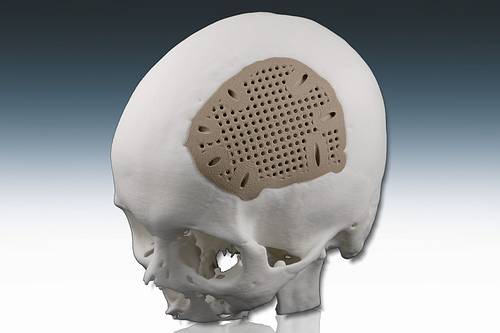Laser Sintering System Enables Development of Complex PEEK Prototypes
February 9, 2011
|
Laser sintering can produce custom PEEK craniofacial implants quickly and economically. |
Manufacturer EOS (Novi, MI) had a lot to share at MD&M West this week regarding its P 800 laser-sintering system. Touted as the first laser-sintering system operating at up to 385°C processing high-performance polymers, the P 800 is enabling development of innovative and traditionally difficult-to-manufacture implants and parts.
As the first and only U.S. company currently in possession of this laser-sintering platform, Royal Engineered Composites (Minden, NE) realized its potential and branched out from the aerospace market to serve the medical device industry, according to Scott Killian, HTLS business development for the company. Within the past year or so, Killian notes, Royal has provided laser-sintered prototypes of orthopedic implants and other medical products, and is considering expanding its capabilities to the industry owing to the success of PEEK part fabrication with the P 800.
"This is a unique process because it allows freeform fabrication; there's no limit to the complexity of the part," Killian adds. The P 800 enables the fabrication of complex geometries, he adds, while the system allows for high-volume production of small parts.
In addition to yielding traditionally difficult-to-manufacture PEEK prototypes in the United States, the system is making waves in Europe as well. While at the show, the company is presenting on a European-funded project that resulted in what they say is the first PEEK craniofacial test implants produced through laser sintering.
PEEK is increasingly replacing titanium in craniofacial implants for patients with head injuries or congenital deformities, according to EOS. "Conventional manufacturing technology can't produce patient-customized craniofacial implants, either titanium or PEEK, as economically or in as short a time span as laser sintering," says Joerg Lenz, EOS collaborative projects coordinator. "EOS technology has enabled us to develop a specific geometry that can only be realized using additive manufacturing. This new design incorporates a mesh scaffold that promotes improved bone growth and optimizes infiltration with a hydroxyapatite-filled, bioabsorbable polymer." -Shana Leonard
You May Also Like



